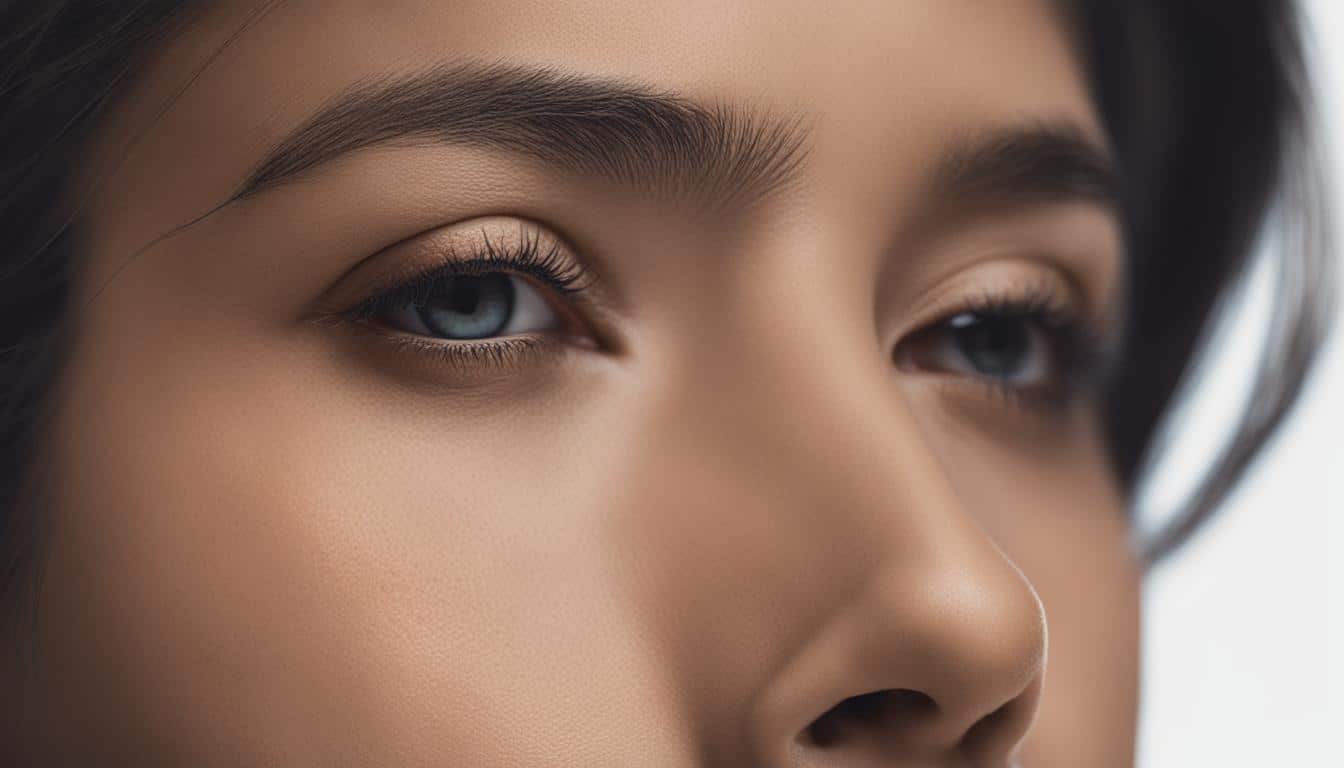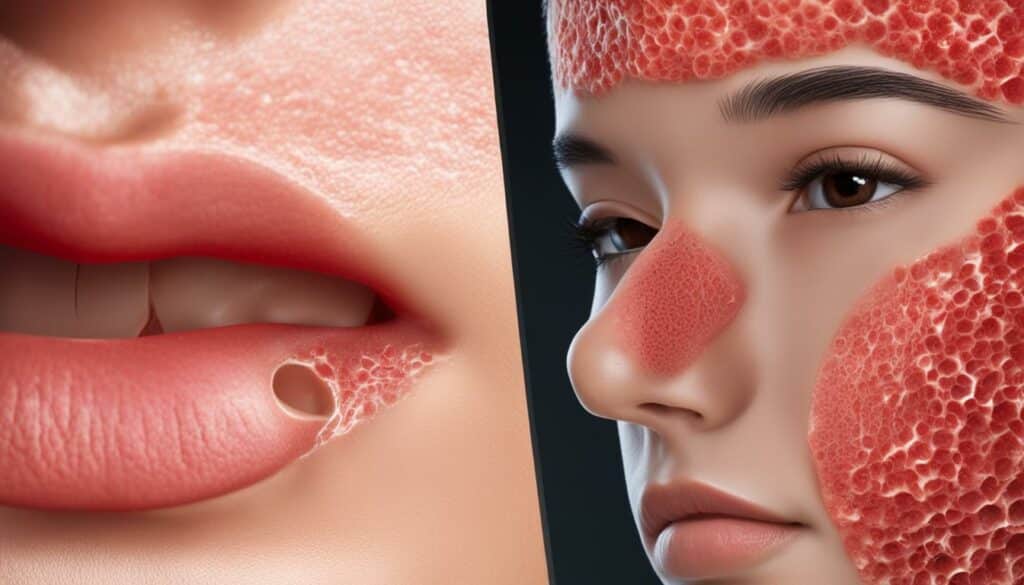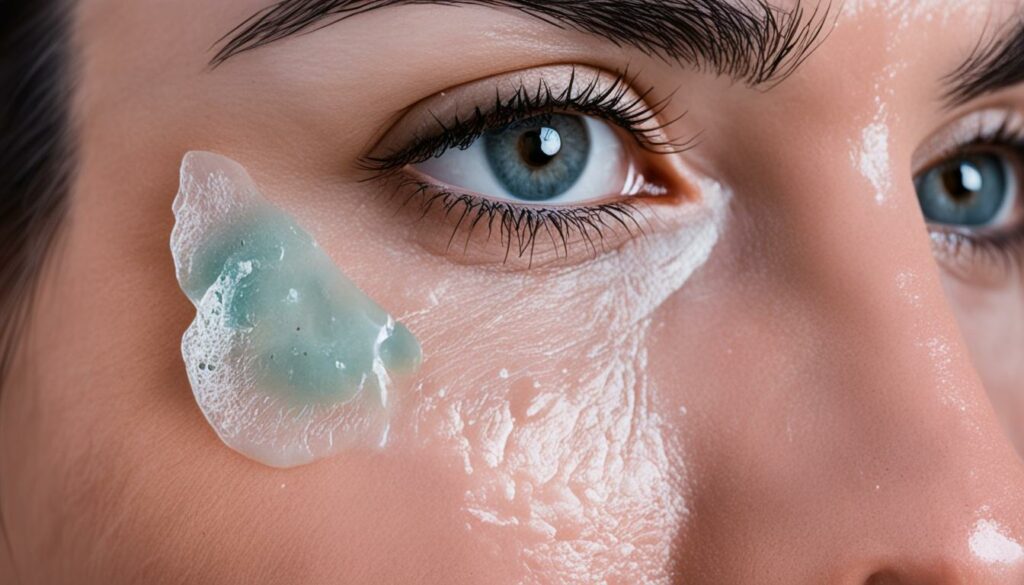
Acne is a common skin condition that affects a large percentage of the population. It occurs when bacteria, oils, and dead skin cells clog up pores, leading to inflammation and the formation of acne lesions. While most acne heals without leaving permanent scars, certain types of acne are more likely to cause scarring. These include papules, pustules, nodules, and cysts.
Acne scars form when there is a breakdown in the wall of the pore, leading to tissue damage and the body’s response to repair the scar by forming new collagen fibers.There are two main types of acne scars: atrophic scars, which result in an indentation in the skin, and hypertrophic or keloid scars, which are raised on the surface of the skin.Treatments are available to help reduce or remove acne scars, depending on their type and severity.
Key Takeaways:
- Not all acne scars are permanent, but certain types of acne are more likely to cause scarring.
- Types of acne scars include atrophic scars (indentations) and hypertrophic or keloid scars (raised).
- Treatments are available to reduce or remove acne scars based on their type and severity.
- Consultation with a dermatologist can help determine the most suitable treatment plan for acne scars.
- With proper care and treatment, it is possible to achieve clearer, smoother skin and regain confidence.
Types of Acne Scarring and Their Appearance
Acne scars can vary in their appearance depending on the type of scarring. There are two main categories of acne scars: atrophic scars and hypertrophic/keloid scars.
Atrophic Scars
Atrophic scars result in depressions or indentations in the skin. There are three common types of atrophic scars:
- Ice Pick Scars: These are small, narrow indentations that point down into the skin, resembling small ice pick holes. They are usually deep and more difficult to treat.
- Boxcar Scars: These scars have sharply defined edges and appear as round or oval depressions with flat bottoms. They are wider than ice pick scars.
- Rolling Scars: Rolling scars have sloping edges that make the skin appear wavy. They are wider than ice pick scars but less deep than boxcar scars.
It is important to note that post-inflammatory hyperpigmentation, which appears as dark spots on the skin, can sometimes be mistaken for acne scars. However, it is a temporary condition that resolves over time.
Hypertrophic/Keloid Scars
Hypertrophic and keloid scars are raised scars that occur when scar tissue builds up. They can be larger than the original acne spot and may extend beyond its boundaries.
Summary
Acne scars come in various forms, including atrophic and hypertrophic/keloid scars. Atrophic scars result in depressions or indentations in the skin, while hypertrophic and keloid scars are raised. It is important to identify the specific type of acne scar to determine the most appropriate treatment.
Prevalence and Causes of Acne Scarring
Acne scars are a common consequence of acne, affecting approximately one in five people with acne. Teenagers are particularly susceptible to acne scarring, with nearly 90% experiencing acne at some point in their lives. The development of acne scars can be attributed to various factors, including the severity and duration of acne, as well as individual factors such as skin type and genetics.
The risk of scarring can be heightened by picking or squeezing acne lesions, as this can lead to further tissue damage and inflammation. Therefore, it is crucial to treat acne promptly and refrain from manipulating or picking at acne lesions to minimize the risk of scarring.

| Risk Factors for Acne Scarring | Prevalence |
|---|---|
| Severity and duration of acne | High |
| Skin type | Variable |
| Genetics | Variable |
| Picking or squeezing acne lesions | High |
By understanding the causes and risk factors associated with acne scarring, individuals can take proactive steps to reduce the likelihood of developing permanent scars and maintain healthier skin.
Prevention and Treatment of Acne Scars
While acne scars cannot always be completely prevented, there are steps you can take to minimize the risk of scarring. One of the most important preventive measures is maintaining a consistent skincare routine that focuses on cleansing and exfoliating the skin. This helps to unclog pores and remove dead skin cells, reducing the likelihood of acne lesions turning into scars.
Using a toner after cleansing can further help to eliminate impurities and reduce the appearance of pores. Additionally, adopting a low-glycemic diet can be beneficial as it helps to regulate blood sugar levels and reduce inflammation, which in turn can lower the severity of acne breakouts.
When it comes to treating acne scars, there are several options available. Professional treatments such as chemical peels, dermabrasion, laser therapy, and microneedling can be highly effective in stimulating collagen production, promoting skin healing, and improving the appearance of scars.
Chemical peels involve the application of a chemical solution to the skin, which exfoliates the outer layer and helps to reduce the appearance of scars. Dermabrasion is a more intensive treatment that uses a rotating device to remove the top layer of skin, allowing new, healthier skin to grow in its place.
Laser therapy uses focused beams of light to target and remove scar tissue, while microneedling involves the use of tiny needles to create controlled micro-injuries, stimulating collagen production and smoothing out the skin’s texture.
For those who prefer home treatments, topical retinoids, which contain Vitamin A derivatives, can be used to reduce the appearance of acne scars. Silicone sheeting is another home treatment option that creates a barrier over the scar, helping to flatten and fade its appearance.
“Prevention is always better than cure. By taking care of your skin and adopting preventive measures, you can minimize the risk of acne scars. However, if you already have scars, professional treatments and targeted home remedies can significantly improve their appearance.” – Dr. Jennifer Smith, Dermatologist

Duration and Candidates for Acne Scar Treatment
The duration of acne scar treatment can vary depending on the type of scar and the treatment method used. Some treatments may need to be repeated periodically to maintain results, while others can offer longer-lasting effects.
For instance, dermal fillers, which are used to plump up depressed scars, may require touch-up sessions every few months to sustain the desired appearance. On the other hand, laser therapy can provide more enduring outcomes, as it works to stimulate collagen production and remodel the scar tissue.
The choice of treatment will ultimately depend on the individual’s specific needs and goals. Consulting with a dermatologist is highly recommended to devise the most suitable treatment plan for a successful outcome.
Good candidates for acne scar treatment are individuals who have persistent, noticeable scars that significantly impact their self-esteem and overall quality of life. These individuals actively seek a solution to improve their skin texture and appearance.
Factors such as the type of acne scars and the person’s skin type will also play a role in determining the most suitable treatment options.
An ideal candidate may exhibit the following characteristics:
- Visible and bothersome acne scars
- A desire to improve the appearance of the scars
- Good general health
- Realistic expectations about the outcomes of the treatment
- Commitment to follow the prescribed treatment plan and post-treatment care
By appropriately identifying candidates for acne scar treatment, healthcare professionals can ensure that individuals receive the most effective and tailored approach to address their specific concerns.
| Treatment Method | Duration |
|---|---|
| Dermal Fillers | Varies; touch-up sessions may be needed every few months |
| Laser Therapy | Results can be long-lasting, with periodic maintenance treatments |
| Chemical Peels | Multiple sessions over several weeks or months may be required |
| Dermabrasion | Several treatments spaced weeks apart |
| Microneedling | A series of treatments, usually 4-6 sessions, with maintenance as needed |
It’s important to note that the duration and treatment options may vary depending on individual circumstances, severity of the scars, and the dermatologist’s assessment.
Conclusion
Acne scars can be a frustrating and self-conscious issue for many individuals. However, it’s important to know that there are permanent solutions available to reduce their appearance or even remove them entirely. The choice of treatment for acne scars depends on the type and severity of the scars, as well as individual factors like skin type. Consulting with a dermatologist is highly recommended to explore the most suitable treatment options.
With proper care and treatment, long-term effects of acne scars can be minimized. It’s important to remember that not all scars are permanent, and there are ways to achieve clearer and smoother skin. Dermatological treatments such as chemical peels, dermabrasion, laser therapy, and microneedling can stimulate collagen production and promote skin healing, leading to noticeable improvements in scar appearance.
Regaining confidence is possible with the right treatment approach. Dermatologists can provide personalized recommendations and suggest appropriate home treatments such as topical retinoids and silicone sheeting. By seeking professional advice and taking proactive steps, individuals can find effective solutions for their acne scars and enjoy the benefits of long-term improvements in their skin’s appearance.
FAQ
Are all acne scars permanent?
No, not all acne scars are permanent. While some types of acne scars can be permanent, others may fade or heal over time.
What are the different types of acne scars?
There are two main types of acne scars: atrophic scars, which result in an indentation in the skin, and hypertrophic or keloid scars, which are raised on the surface of the skin.
How can I identify permanent acne scars?
Permanent acne scars are typically characterized by deep indentations or raised areas on the skin that persist even after the initial acne has healed.
What treatment options are available for permanent acne scars?
There are various treatment options available for permanent acne scars, including professional treatments such as chemical peels, dermabrasion, laser therapy, and microneedling. Home treatments, such as topical retinoids and silicone sheeting, can also be used to reduce the appearance of acne scars.
Can acne scars be completely removed?
While it may not be possible to completely remove all acne scars, various treatments can significantly reduce their appearance and improve the overall texture and tone of the skin.
How long does acne scar treatment last?
The duration of acne scar treatment can vary depending on the type of scar, the treatment method used, and individual factors. Some treatments may need to be repeated periodically to maintain results, while others can offer longer-lasting effects.
Who is a good candidate for acne scar treatment?
Good candidates for acne scar treatment are individuals who have persistent, noticeable scars that are affecting their self-esteem and quality of life. The type of acne scars and skin type will also play a role in determining the best treatment options.
Can acne scars be prevented?
While not all acne scars can be prevented, there are measures that can be taken to minimize the risk of scarring. This includes maintaining a good skincare routine, avoiding picking or squeezing acne, and seeking prompt treatment for acne breakouts.
What are the long-term effects of acne scars?
Acne scars can have long-term effects on a person’s self-esteem and confidence. However, with proper treatment and care, it is possible to reduce their appearance and regain smoother, clearer skin.
